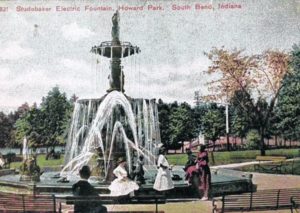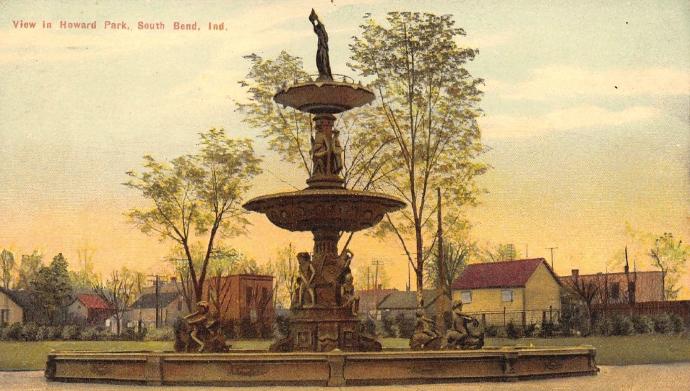The Studebaker Electric Fountain, a symbol of civic pride in South Bend, Indiana when it was unveiled in 1906, will be restored and repositioned in a prominent public spot.
In 1876, John Studebaker, President of the Studebaker Brothers Wagon Works, took his display wagon to the United States Centennial Exposition in Philadelphia, Pennsylvania. J.L. Mott Ironworks from New York brought an elaborate cast iron fountain to the Exposition to display.
 Mott’s fountain was 25 feet tall, and was said to have the largest cast-iron basin in the United States. Studebaker decided to order one of these fountains to bring back to the City of South Bend.
Mott’s fountain was 25 feet tall, and was said to have the largest cast-iron basin in the United States. Studebaker decided to order one of these fountains to bring back to the City of South Bend.
On July 21, 1906, the fountain arrived. It was electrified with hanging light bulbs, donated to the City by John Studebaker, and was placed in Howard Park. The fountain stood 28 feet high with the bottom basin about 34 feet in diameter. The cost was nearly $10,000.
Thousands came to Howard Park to celebrate the dedication of the fountain, reported then as an “…imposing ornate font with splashing waters illuminated by electric lights.”
Citizens continued to enjoy the beauty of the fountain for almost 35 years until 1939. As World War II began, the City Parks dismantled the fountain. Many believed that the fountain had been melted down as scrap metal.
Fortunately, a local family had rescued many pieces from destruction and the family moved the fountain and its pieces (the top 1/3 of the fountain, 3 boys on dolphins, and two turtles) to their home along the river in Osceola, where it continued to operate as a fountain until 2009.
That same year, the Seiler family donated the fountain and all of its pieces to The History Museum.
The fountain then went missing for 68 years. The top two-thirds of it came into the possession of a local family, and it was displayed in their Osceola yard for nearly 50 years until 2009, when it was donated to The History Museum.
The fountain was made by J.L. Mott Iron Works Company, which went bankrupt in the 1930s.
McKay Lodge Fine Art Conservation Laboratory Inc. of Oberlin, Ohio has been commissioned to do the restoration.
Fortunately, the Robinson Iron Corporation of Alexander City, Alabama is in possession of the original J.L. Mott molds. McKay Lodge has contracted them to recast the missing pieces.
So important is the fountain to the city’s heritage that it took under eight months for local citizens to privately raise $648,900 for the restoration.
The City of South Bend committed to providing the infrastructure and installation for the project, and expects the official unveiling to take place in Leeper Park in the summer 2019.
“This is truly a community achievement,” Mayor Pete Buttigieg said during a celebration at The History Museum to mark the departure of the fountain pieces for restoration. South Bend residents are building a new community, but it’s one that’s true to its historic roots, he said.
“Our magnificent fountain is coming home to once again be a landmark of pride for our community,” volunteer Vicki McIntire said. The generous contributions “will ensure your fountain will never be torn down again,” she said.
The fund drive was led by McIntire and Brandon Anderson, deputy executive director of The History Museum.
Featured images are a historic postcards of the fountain, dates and authors unknown.
See Studebaker Electric Fountain website.
See full article by Margaret Fosmoe in the South Bend Tribune.

